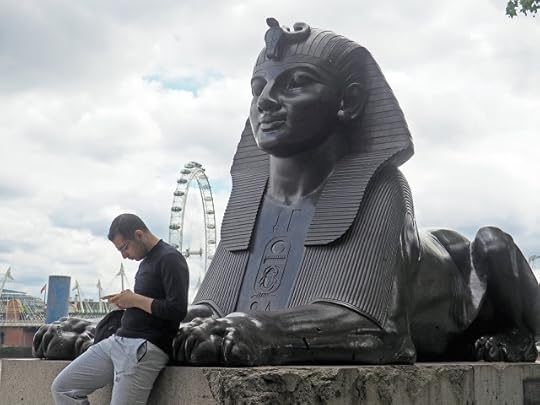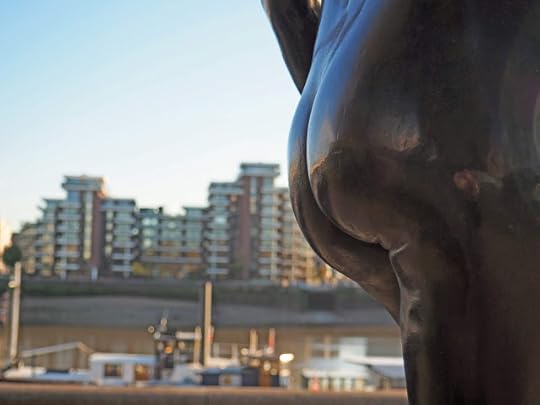Geoff Nicholson's Blog, page 33
November 28, 2018
GAIT ANALYSIS
I went to see Gilbert Shelton at the British Library, in conversation with Posy Simmons. They were mostly there to talk about cats – there’s a new exhibition at the library Cats on the Page.
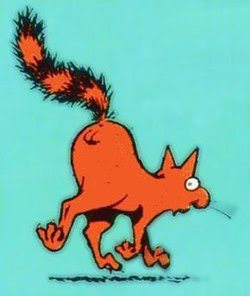
Of course Shelton was there because of Fat Freddy’s Cat (above), a noble and subversive animal, though not bearing much relationship to any real cat. Shelton was far more scholarly than I’d expected him to be, and he did say something I absolutely agree with, that cats don’t really have facial expressions – we simply project our feelings onto them. Cartoon cats of course have the most expressive faces, and indeed gaits, imaginable.
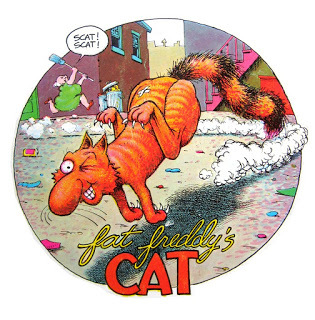
Shelton has always struck me as the most benign and engaging of the underground comix crowd, less consciously transgressive than most. The Fabulous Furry Freak Brothers weren’t as hip as they thought they were, or were trying to be, and that was a source of the comedy, and when it came to subversion, dope smoking and a distrust of the police was about as far as it went.
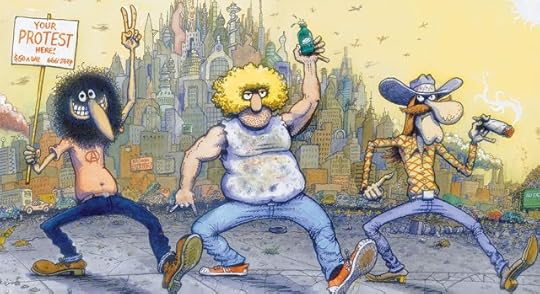
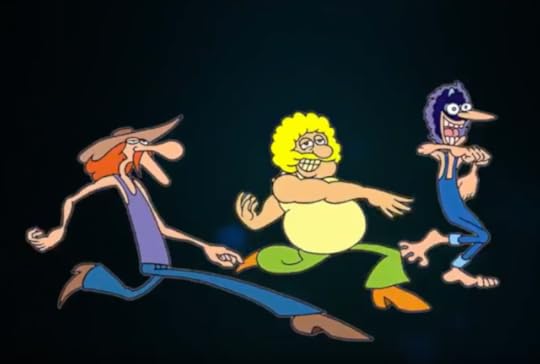
At one point the onstage conversation turned to the various attempts that have been made to animate the Freak Brothers. They certainly have a very specific walking gait, which looks just fine in still cartoons but seems a real problem when it comes to animation. There's this curious teaser floating around on Youtube, which shows you how hard it is to make them walk convincingly, or in fact move at all:
Shelton is about far more than just the Freak Brothers. I was always taken with Philbert Desenex who walked looking like this:
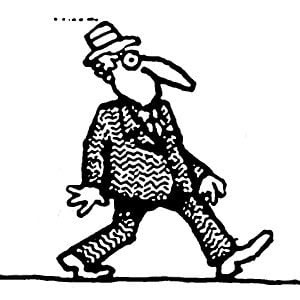
And then turned into Wonder Warthog who in general does more flying than walking, though not always
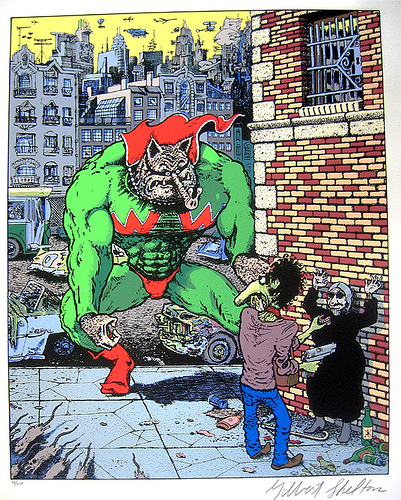
And digging around online I can across this Shelton image. Trangressive no doubt, and also depicting a very fine, if again unlikely, gait.
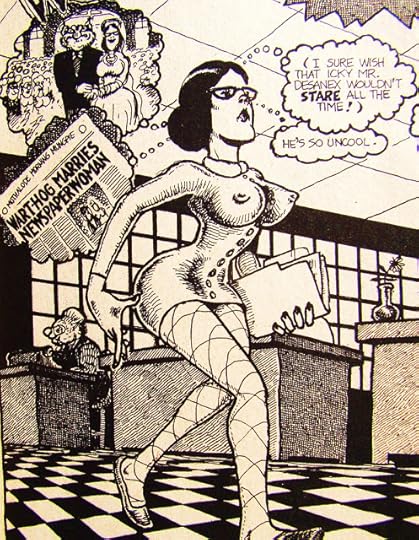
And if you're interested, this is what Gilbert Shelton looks like these days:



Of course Shelton was there because of Fat Freddy’s Cat (above), a noble and subversive animal, though not bearing much relationship to any real cat. Shelton was far more scholarly than I’d expected him to be, and he did say something I absolutely agree with, that cats don’t really have facial expressions – we simply project our feelings onto them. Cartoon cats of course have the most expressive faces, and indeed gaits, imaginable.

Shelton has always struck me as the most benign and engaging of the underground comix crowd, less consciously transgressive than most. The Fabulous Furry Freak Brothers weren’t as hip as they thought they were, or were trying to be, and that was a source of the comedy, and when it came to subversion, dope smoking and a distrust of the police was about as far as it went.


At one point the onstage conversation turned to the various attempts that have been made to animate the Freak Brothers. They certainly have a very specific walking gait, which looks just fine in still cartoons but seems a real problem when it comes to animation. There's this curious teaser floating around on Youtube, which shows you how hard it is to make them walk convincingly, or in fact move at all:
Shelton is about far more than just the Freak Brothers. I was always taken with Philbert Desenex who walked looking like this:

And then turned into Wonder Warthog who in general does more flying than walking, though not always

And digging around online I can across this Shelton image. Trangressive no doubt, and also depicting a very fine, if again unlikely, gait.

And if you're interested, this is what Gilbert Shelton looks like these days:


Published on November 28, 2018 02:29
November 25, 2018
CACTI IN CAPTIVITY

One of the best things that happened to me while I was living in Los Angeles was that I became a lover of xerophiles – a xerophile-phile , if you like. A xerophile is an organism that thrives in very dry environments. This includes (though is by no means limited to) cacti, succulents and my particular favorite - euphorbia.

You see them everywhere as you walk around in Los Angeles. LA is not by any standard a desert, but xerophiles like the climate there and grow very well indeed. You see them in a great many gardens, and I got to the stage where I could hardly walk down the street, any street, without stopping staring, sometimes taking photographs, very occasionally making field notes.
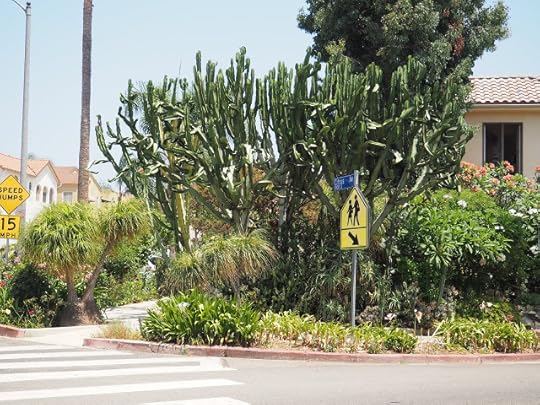
Here in London it’s not hard to fine xerophile lovers, but they don’t grow their xerophiles outdoors in the earth. They grow them in pots that they bring inside for the winter.

So as I walk around London I don’t see any xerophiles growing in gardens but I see plenty in pots, especially in shop windows.
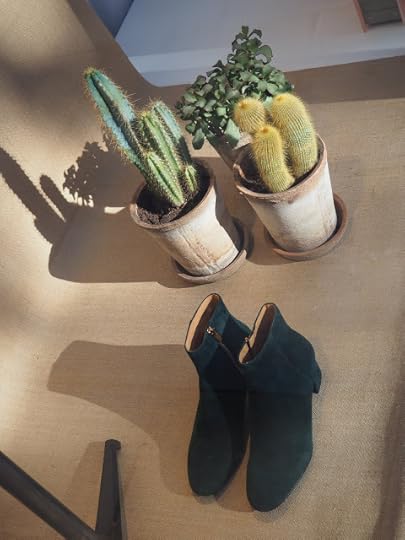
I’m told that this London cactus thing is a bit of a fad and may soon wear off, so I’ll enjoy it while I can.
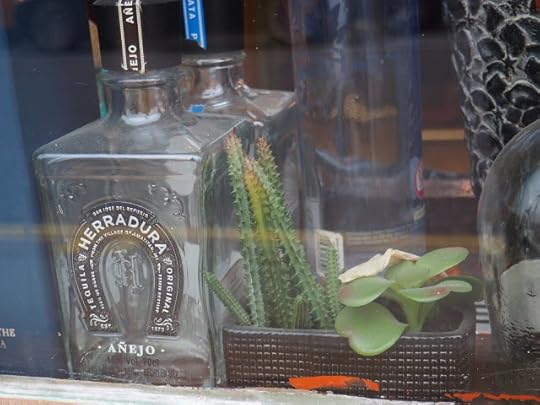
But if you really want to walk among xerophiles in London you need to go down to Kew Gardens, to the Princess of Wales Conservatory.
 Official Kew photograph.It actually has ten climate zones, has two areas devoted to carnivorous plants, and contains a Titan Aurum which produces the stench of rotten flesh to attract insects. Hey, you won’t find me making distasteful jokes about England’s Rose.
Official Kew photograph.It actually has ten climate zones, has two areas devoted to carnivorous plants, and contains a Titan Aurum which produces the stench of rotten flesh to attract insects. Hey, you won’t find me making distasteful jokes about England’s Rose. 
Published on November 25, 2018 03:45
November 19, 2018
WALKING BIGLY, WITH BEN
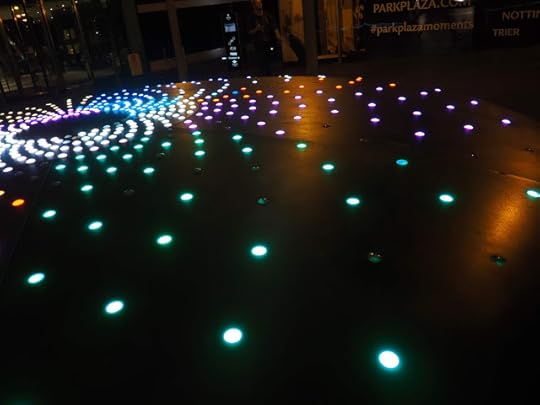
As I walk around London in mid-November, especially at night (although “night” starts at about half past four), I’m struck by how much of it is lit up. Some of it is in honour of the approaching Christmas, but by no means all. County Hall and the London Eye (which if you’re in the right frame of mind can look like the portal to another dimension) are evidently illuminated to compliment and contrast with each other. They look great.
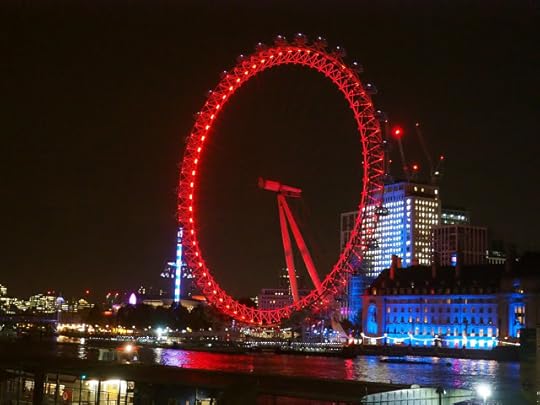
I’m reminded of a time when I was a student, and I brought a friend down to London from the boonies to show him the sights, even though my own knowledge of the sights was extremely limited at that stage.The friend was a man of, let’s say, very specific imagination. London disappointed him at every turn because it wasn’t exactly as he’d imagined it. He’d thought the Thames would be much wider, Buckingham Palace far more palatial, and specifically that Big Ben would be much, much bigger.
I think he probably had a point with Big Ben. The name is confusing, chiefly because the bigness originally referred only to the bell inside – which is indeed very big and impressive, but since you can’t see it from outside, it’s easy to understand somebody's disappointment.

Now it so happened that last week I walked over Westminster bridge and back. I walked south in daylight (pushing through crowds of tourists and selfie-takers) and north in (illuminated) darkness, by which time there were fewer self-takers, but still a surprising number.
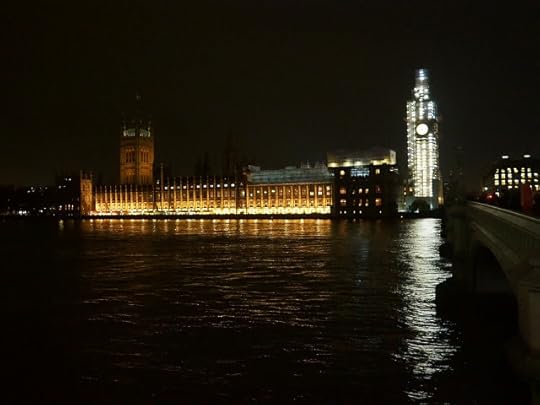
Big Ben is currently being refurbished, and not set to reopen to the public until 2012, so the whole thing is wrapped up, like something by Christo, and at night it's all lit up; not exactly like a Christmas tree, but I suspect it’s never looked better:
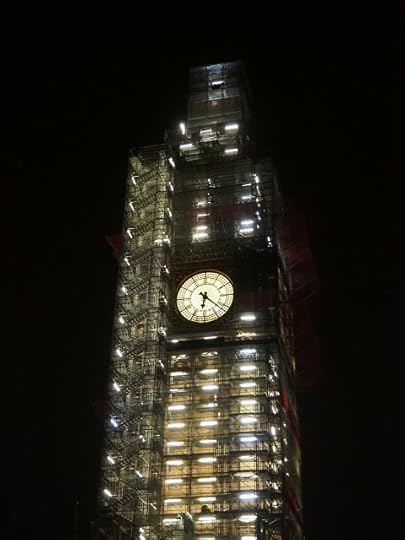
And then I was in Dalston at the weekend and walked past a furniture shop that had this in the window:
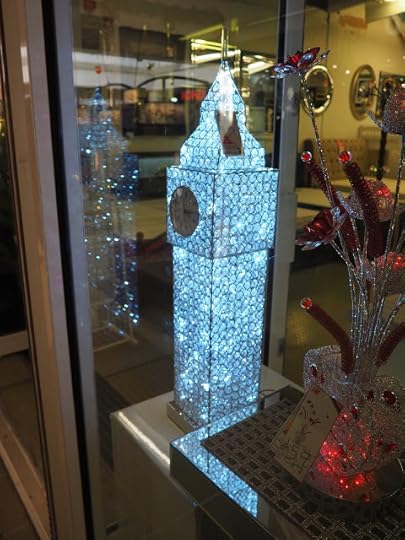
It had no price on it, perhaps in a “if you have ask …” kind of way, but on this occasion it looked surprisingly like the “real thing.” My friend from the north would still not have been impressed, I’m sure. But I'm thinking that maybe I should dash back to Dalston and buy it - damn the expense.

Published on November 19, 2018 08:25
November 12, 2018
FOSTER AND DRACULA

“Presently, with an excuse, he left me, asking me to put all my papers together. He was some little time away, and I began to look at some of the books around me. One was an atlas, which I found opened naturally at England, as if that map had been much used. On looking at it I found in certain places little rings marked, and on examining these I noticed that one was near London on the east side, manifestly where his new estate was situated.”
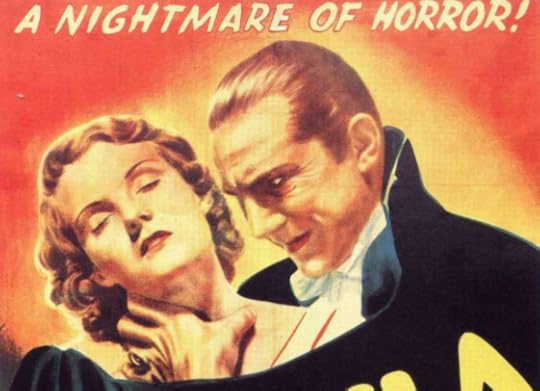
The “he” in that passage – you probably guessed - is Count Dracula, and Bram Stoker’s Dracula has been on my mind because I was walking again with Foster Spragge, a woman who draws rings on maps. Although perhaps to be more precise she probably uses the rings to create maps of a unique kind, but either way you understand the connection.
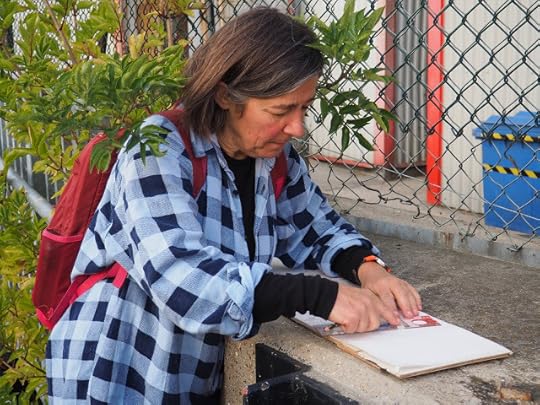
Dracula, like many a well-heeled immigrant before and since, moves to England and starts buying up property – a house in Piccadilly and another in Purfleet – that’s the place that’s “near London on the east side,” and that’s where Foster and a group of us walked – from Rainham to Purfleet, both in Essex – a mere five miles, but a vital and final part of Spragge’s 150 mile walk - Drawing Dialogue London Loop.

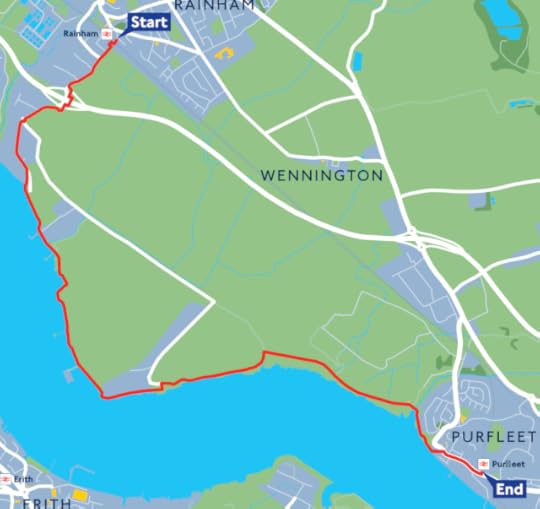
It was a terrific section of the walk to be on – starting early afternoon and ending at dusk, by which time the light was extraordinary and I was thinking of the opening of Heart of Darkness:
"The day was ending in a serenity of still and exquisite brilliance. The water shone pacifically; the sky, without a speck, was a benign immensity of unstained light; the very mist on the Essex marshes was like a gauzy and radiant fabric, hung from the wooded rises inland, and draping the low shores in diaphanous folds. Only the gloom to the west, brooding over the upper reaches, became more somber every minute, as if angered by the approach of the sun."
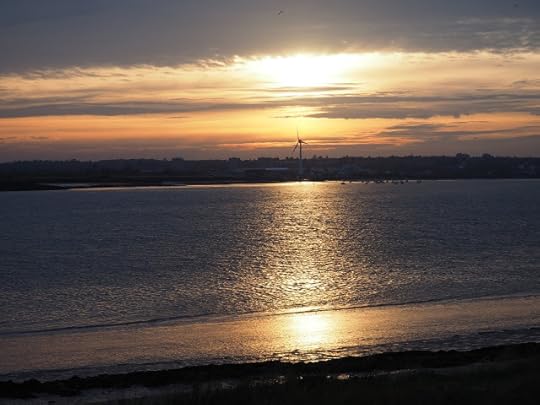
Along the way there were giant sheds and giant hogweed:


Cats (more than just this one):

Outsider art:
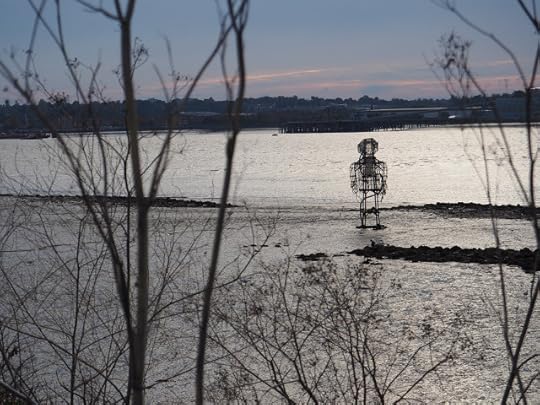
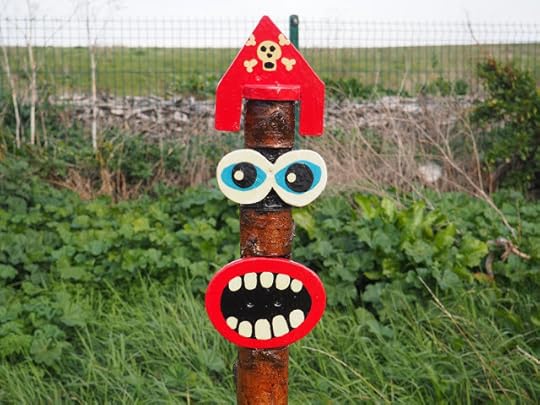
Concrete barges:
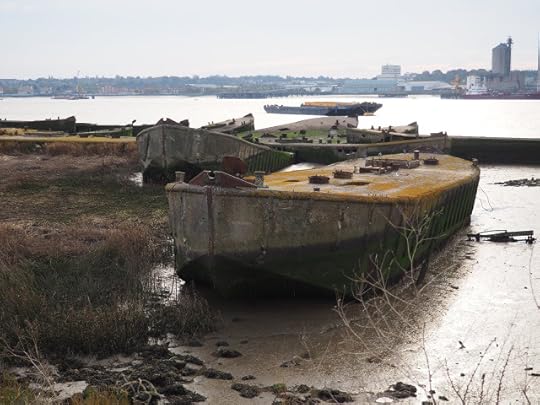
And much more besides.
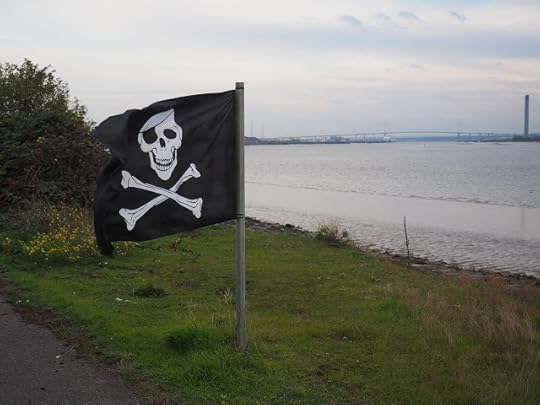
Better scholars than I have asserted that there isn’t and has never been a house in Purfleef that fits the description of Dracula’s property there, named Carfax. However I did see this place which with some modifications might be turned into a very cool, quasi-industrial home, though I suppose you'd have to work pretty hard to give it the Gothic qualities Dracula was looking for.

In Chelsea the next day I took a walk past Bram Stoker’s former digs at 188 St Leonard’s Terrace. That didn’t look very Gothic either.
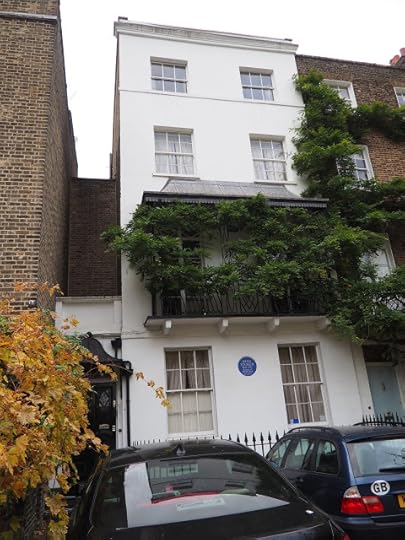
Zoopla estimates its current price as £9,183,000 which is strangely precise for an estimate, and seems a bit steep even for Chelsea, but what do I know?
These are the kind of things you think about while walking in Chelsea, actually while walking pretty much anywhere, these days. Of course that doesn’t necessarily stop you thinking about the Undead.
This is Dracula walking in the streets of London in the 1931 movie:
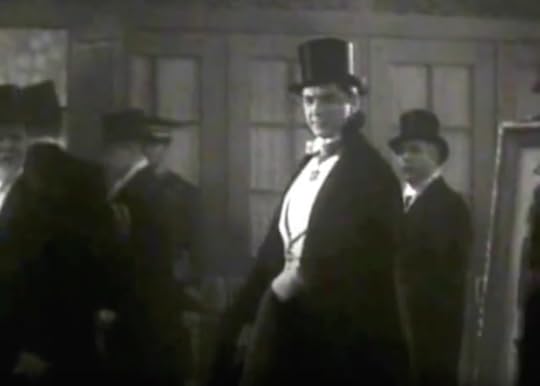

Published on November 12, 2018 06:16
November 8, 2018
WAR WALKS
Lawrence Weschler would probably call this a convergence. I’m not sure what it is, but it doesn’t seem entirely a coincidence.
As we mark the 100 year anniversary of end of the First World War (“So then we all lived in peace, did we dad?”), I saw this painting by John Singer Sergeant titled “Gassed,” painted in 1919.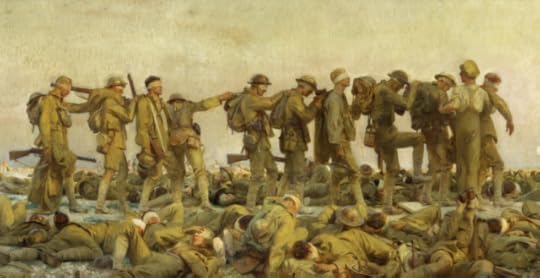
It’s owned by the London Imperial War Museum, which describes it thus:
“A side on view of a line of soldiers being led along a duckboard by a medical orderly. Their eyes are bandaged as a result of exposure to gas and each man holds on to the shoulder of the man in front. One of the line has his leg raised in an exaggerated posture as though walking up a step, and another veers out of the line with his back to the viewer. There is another line of temporarily blinded soldiers in the background, one soldier leaning over vomiting onto the ground. More gas-affected men lie in the foreground, one of them drinking from a water-bottle. The crowd of wounded soldiers continues on the far side of the duckboard, and the tent ropes of a dressing station are visible in the right of the composition. A football match is being played in the background, lit by the evening sun.”
I kept looking and looking at this image, and admittedly I was only looking at a jpg – the painting is mighty big – but it took me a very, very long time to see that football match. It’s there but the resolution is low enough that anyone might be forgiven for not spotting it:
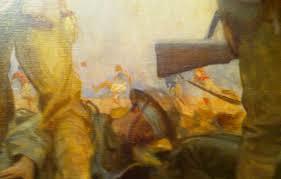
The painting apparently, and clearly, references “The Parable of the Blind” by Breughel the Elder, 1568, which I absolutely believes shows no football match.
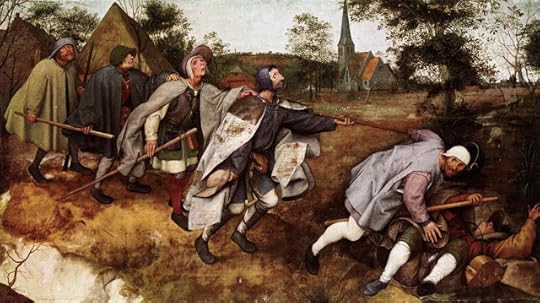
I was then reminded of “Blind Field Shuttle” a performance work by the artist Carmen Papalia, who is blind, and who leads people on walks as they follow behind him, hands on the shoulder of the walker in front, their eyes held shut. I’d have thought blindfolds would have make the work better, but probably there are health and safety issues. The event, which obviously changes all the time, sometimes looks like this:
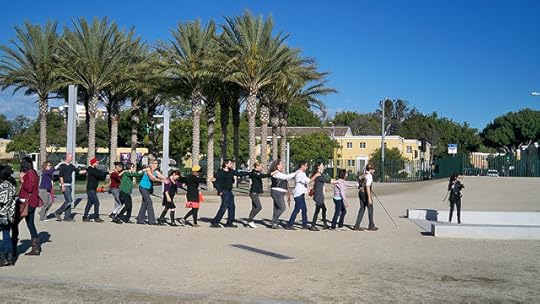

And then, out of nowhere, (and of course I realize that with the Internet, there’s no such place as nowhere, and perhaps there’s no such thing as a convergence, and certainly no coincidence, and no doubt it’s all algorithms) this image appeared on my Facebook, plugging Google.

There’s no blindness, no hands on shoulders, and of course no gassing, and yet there does seem to be some resemblance or echo or something. I’m still not sure if I ought to be outraged by this.
As we mark the 100 year anniversary of end of the First World War (“So then we all lived in peace, did we dad?”), I saw this painting by John Singer Sergeant titled “Gassed,” painted in 1919.

It’s owned by the London Imperial War Museum, which describes it thus:
“A side on view of a line of soldiers being led along a duckboard by a medical orderly. Their eyes are bandaged as a result of exposure to gas and each man holds on to the shoulder of the man in front. One of the line has his leg raised in an exaggerated posture as though walking up a step, and another veers out of the line with his back to the viewer. There is another line of temporarily blinded soldiers in the background, one soldier leaning over vomiting onto the ground. More gas-affected men lie in the foreground, one of them drinking from a water-bottle. The crowd of wounded soldiers continues on the far side of the duckboard, and the tent ropes of a dressing station are visible in the right of the composition. A football match is being played in the background, lit by the evening sun.”
I kept looking and looking at this image, and admittedly I was only looking at a jpg – the painting is mighty big – but it took me a very, very long time to see that football match. It’s there but the resolution is low enough that anyone might be forgiven for not spotting it:

The painting apparently, and clearly, references “The Parable of the Blind” by Breughel the Elder, 1568, which I absolutely believes shows no football match.

I was then reminded of “Blind Field Shuttle” a performance work by the artist Carmen Papalia, who is blind, and who leads people on walks as they follow behind him, hands on the shoulder of the walker in front, their eyes held shut. I’d have thought blindfolds would have make the work better, but probably there are health and safety issues. The event, which obviously changes all the time, sometimes looks like this:


And then, out of nowhere, (and of course I realize that with the Internet, there’s no such place as nowhere, and perhaps there’s no such thing as a convergence, and certainly no coincidence, and no doubt it’s all algorithms) this image appeared on my Facebook, plugging Google.

There’s no blindness, no hands on shoulders, and of course no gassing, and yet there does seem to be some resemblance or echo or something. I’m still not sure if I ought to be outraged by this.

Published on November 08, 2018 12:45
November 3, 2018
MORE LONDON EXCURSIONS
Published on November 03, 2018 05:25
October 30, 2018
PHOTOGRAPHS OF FANCY TRICKS
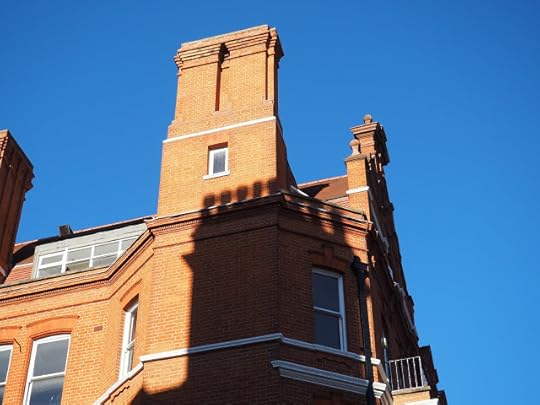
An apparently simple question: when Elvis Costello sings “I don't want to go to Chelsea” - to which Chelsea is he referring? The one in London SW3, surely. The appearance of a character called Elsie rather confirms the point. But I suppose he was smart enough to know there was also a Chelsea in Manhattan, and he may have used that to give the song wider, if more oblique, appeal.
And when he sings, “Oh no it does not move me/Even though I've seen the movie” to which movie is he referring? You might well think Warhol’s Chelsea Girls, though that doesn’t fit at all with the rest of the lyrics.
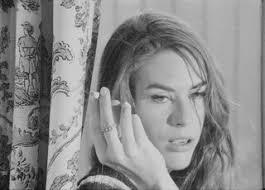
Of course all manner of movies had used Chelsea as a location, long before Costello wrote his song; swinging sixties movies, and even A Clockwork Orange - the record store scene was shot in the Chelsea Drugstore, a place I’m old enough to have been in. It’s now a McDonald’s, natch.
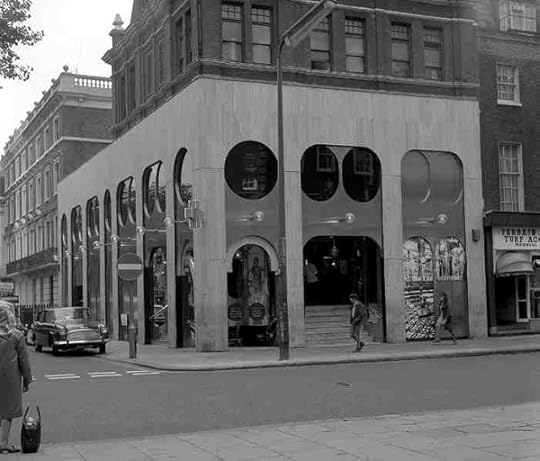
I’m also old enough to remember walking up and down the King’s Road (the apostrophe comes and goes) looking at the punks. We were (pace Simon Reynolds) definitely in the post-punk era but a lot of people hadn’t got the memo. The pic below is dated 1980.
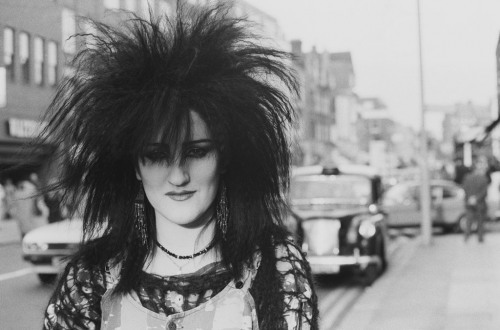
I was too late for Westwood and McLaren’s Sex but I was there for World’s End. We used to go in and laugh at the clothes, and then laugh even harder at the prices. It’s still there, kind of.
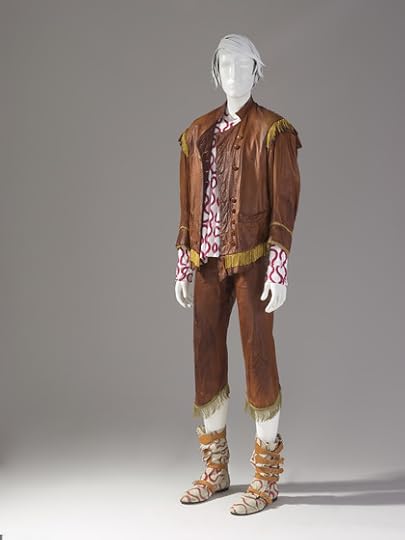
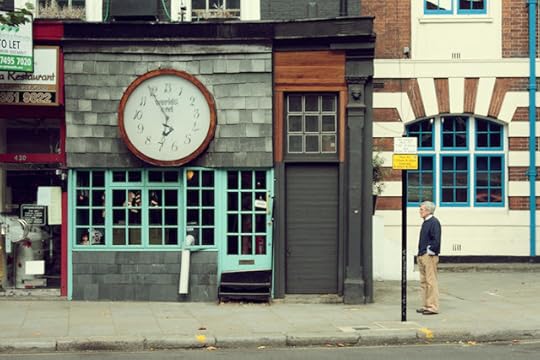
But there were plenty of other reasons to go to Chelsea: the Royal Court Theater, the Chelsea Physic Garden, the Chelsea Potter (a pub), and for Pete’s sake I got married there at Chelsea Town Hall. And it’s a pretty decent area to walk, mostly flat, and mostly interesting once you get in the side streets.
So this whole “I don’t want to go to Chelsea” thing doesn’t really apply to me, even though I feel like an imposter as I walk around. Not a real Chelsea guy. But now I find myself, for the next 6 months or so, residing in Chelsea, subletting a flat that I can’t really afford – as is the way with flats in London.
But at least the universe is sending me messages to make me feel at home here. Right across the street is a place called Footopia!
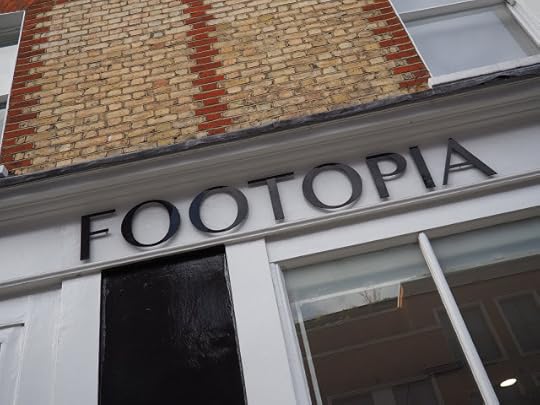
And around the corner there’s a VW Bus with a customized front end. I assume it moves from time to time, but it hasn’t so far.

And today I was walking to the Waitrose mini-supermarket and I saw a tall, rangy black man coming from the opposite direction, walking with some difficulty, using a stick, and I looked at him sympathetically, and he looked and me and said, “All right, captain?” Nobody has ever called me captain before.

Published on October 30, 2018 15:07
October 24, 2018
WALKING WITH FOSTER
Last Sunday I walked from Uxbridge to Manor Park, Tube station to Tube station, most of it along the London Loop, much of it along the Grand Union Canal. That’s not my usual kind of walking territory, which was an attraction in itself, and another attraction was that I was walking with Foster Spragge who is sometimes described as a walking artist, and at the very least is an artist who sometimes uses walking as part of her “practice.” This is her:
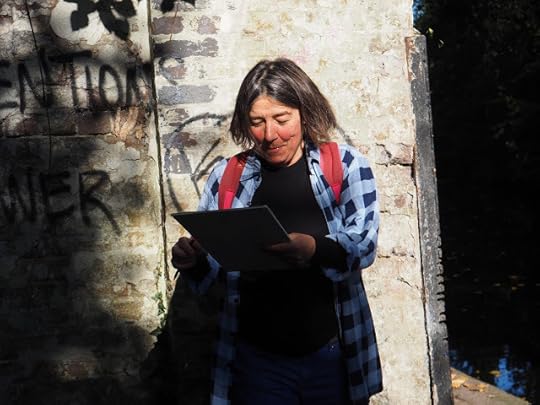
The overall title of the project is "Drawing Dialogues on the London Loop," and it’s connected with an organization named tickbirdandrhino, the brainchild of Mat Clum, who was also on the walk. It says on the website that Foster’s “current work involves a series of drawings created whilst investigating, walking and/or swimming in real time through specific environments - making marks that resonate within her sense of self and place.” Sounds about right.
We met at Uxbridge station, which is quite a destination in itself. Is it the only London tube station that has stained glass? Surely somebody will tell me.
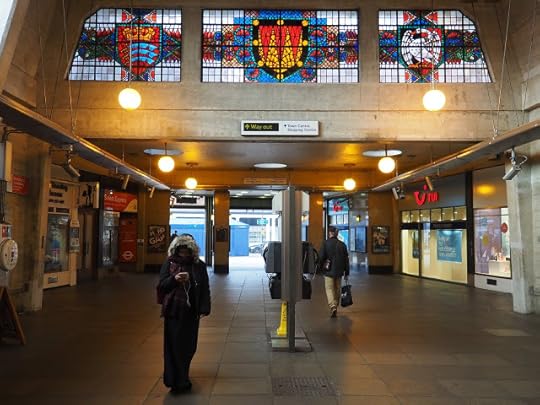
I was on Walk 9. There are 15 walks most of them in 2 parts of about 5 miles each, though the last walk is 3 parts. I’ll be there for at least some of that.

The project is partly about mapping. We were following maps created by Transport for London and as we walked, Foster held a clipboard which made her look like a council official doing a survey rather than an artist, which in some way seemed a good thing. It certainly stopped people asking questions.
On the board was a sheet of paper, marked up with a line of marks or holes. Every 7 minutes as we walked she used a compass embedded in a clear plastic ruler with 2 circular holes, and centered it on the spot marked by a hole, drew a line marking the north/south axis, and a couple of circles. I think I’ve got that right but I do stand to be corrected. This created gorgeously inscrutable images that will, I believe, ultimately be used to inspire a different work of art.
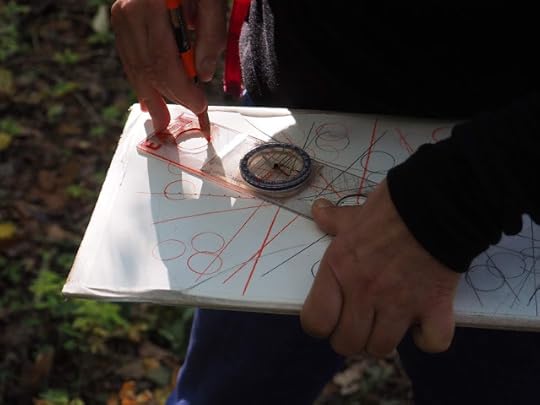
We agreed that it would be possible to use this as a map to, as it were, reverse engineer the route, but why would anybody do that?
And so we walked – just 4 of us as it turned out – and we looked around and observed, and took some photographs. Much of the walk was quite watery;
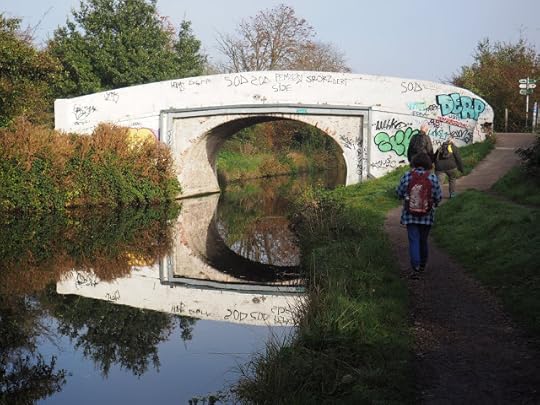
There was some wild(ish) life – a fake crocodile (alligator?) and a real cat
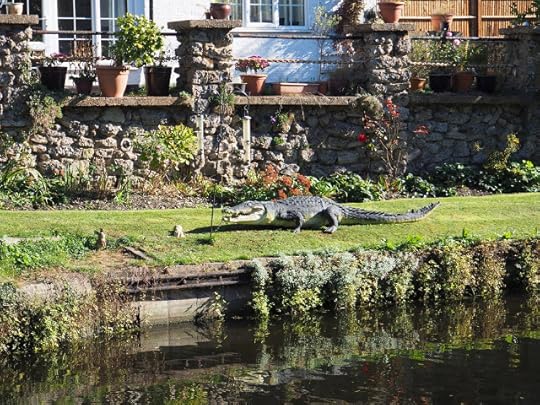
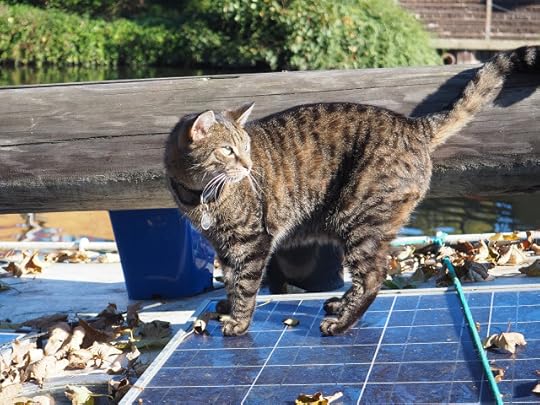
And suddenly, as we got near to Moor Park, the path took us right into the middle of a very fancy bit of suburbia. There were security cameras trained on us, so obviously we waved to them. This part was wildly out of keeping with the rest of the walk and although I’m well aware of the contested evils of suburbia, I am fascinated by that kind neatness, by which I mean other people’s, since I’m quite incapable of living like that. I am also a sucker for topiary:

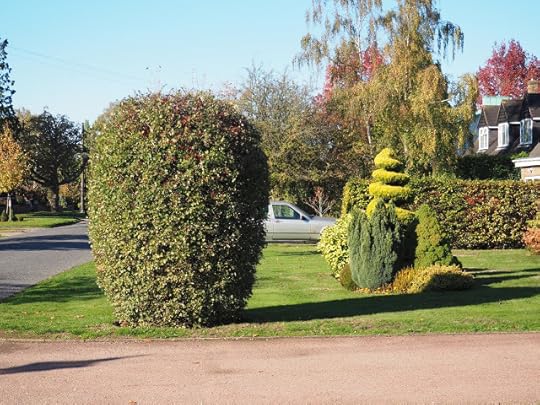
We covered about ten miles. I could have walked further if I’d had to, but I was glad I didn’t have to.
This is Forster Spragge’s website:http://www.fosterspragge.com
This is tickbirdandrhinotickbirdandrhino.com


The overall title of the project is "Drawing Dialogues on the London Loop," and it’s connected with an organization named tickbirdandrhino, the brainchild of Mat Clum, who was also on the walk. It says on the website that Foster’s “current work involves a series of drawings created whilst investigating, walking and/or swimming in real time through specific environments - making marks that resonate within her sense of self and place.” Sounds about right.
We met at Uxbridge station, which is quite a destination in itself. Is it the only London tube station that has stained glass? Surely somebody will tell me.

I was on Walk 9. There are 15 walks most of them in 2 parts of about 5 miles each, though the last walk is 3 parts. I’ll be there for at least some of that.

The project is partly about mapping. We were following maps created by Transport for London and as we walked, Foster held a clipboard which made her look like a council official doing a survey rather than an artist, which in some way seemed a good thing. It certainly stopped people asking questions.
On the board was a sheet of paper, marked up with a line of marks or holes. Every 7 minutes as we walked she used a compass embedded in a clear plastic ruler with 2 circular holes, and centered it on the spot marked by a hole, drew a line marking the north/south axis, and a couple of circles. I think I’ve got that right but I do stand to be corrected. This created gorgeously inscrutable images that will, I believe, ultimately be used to inspire a different work of art.

We agreed that it would be possible to use this as a map to, as it were, reverse engineer the route, but why would anybody do that?
And so we walked – just 4 of us as it turned out – and we looked around and observed, and took some photographs. Much of the walk was quite watery;

There was some wild(ish) life – a fake crocodile (alligator?) and a real cat


And suddenly, as we got near to Moor Park, the path took us right into the middle of a very fancy bit of suburbia. There were security cameras trained on us, so obviously we waved to them. This part was wildly out of keeping with the rest of the walk and although I’m well aware of the contested evils of suburbia, I am fascinated by that kind neatness, by which I mean other people’s, since I’m quite incapable of living like that. I am also a sucker for topiary:


We covered about ten miles. I could have walked further if I’d had to, but I was glad I didn’t have to.
This is Forster Spragge’s website:http://www.fosterspragge.com
This is tickbirdandrhinotickbirdandrhino.com

Published on October 24, 2018 05:44
October 23, 2018
HOLLYWOOD TO GO
As I bounce around from Airbnb to hotel to people’s spare rooms, I have to consider the possibility that this makes me an e-nomad. If so, it’s a damn exhausting way of life, although it does mean that you’re regularly arriving in some new place with plenty of options for walking, and “the exploration of a fixed spatial field” (as M. Debord would have it), and also of course for disorientation. I get gently lost pretty much every day.
And it so happens that I’ve briefly ended up in a flat in Harcourt Terrace SW10, between Fulham Road and Old Brompton Road, an area which might possiblybe thought of as Chelsea, though the nearest Tube station is Earls Court. Either way it’s a fairly swanky area, but here’s the thing for a man who sometimes styles himself as a Hollywood Walker: if you walk south down Harcourt Terrace, it suddenly becomes – now wait for it - Hollywood Road.

There’s a Hollywood Lodge:

These people are staring into Hollywood Mews, which has a very nice font:

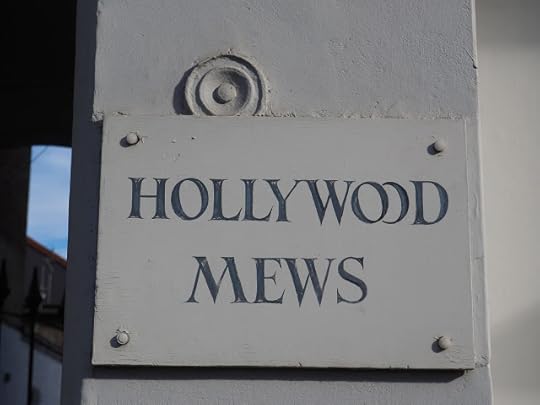
There’s a salon offering Hollywood Hair and Nails:

There is even the Hollywood Arms, a pub that’s been there since 1865:
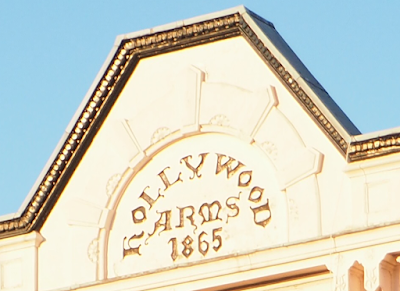
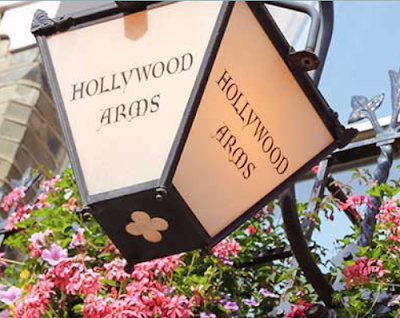
None of this, naturally, has much in common with the Californian Hollywood: there’s money there, but there’s also muck. Finding signs of patina and decay is a quite a job in this bit of London – but as I pounded the streets I did feel quite cheered when I saw this ghost sign:

It’s a former showroom for Metcalfe and Mundy who, I discover, were the sole Borgward concessionaires for the whole country.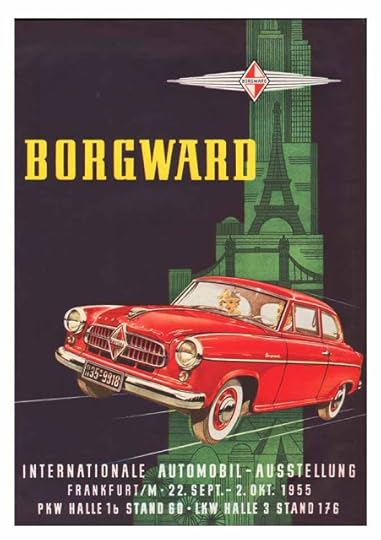
Borgward were good looking cars but they went out of business in 1961 (though the brand has recently been revived) so this is one very old surviving sign. Fortunately Metcalfe and Mundy didn’t have to rely only on the Borgward. They did a pretty nice line in Aston Martins too.
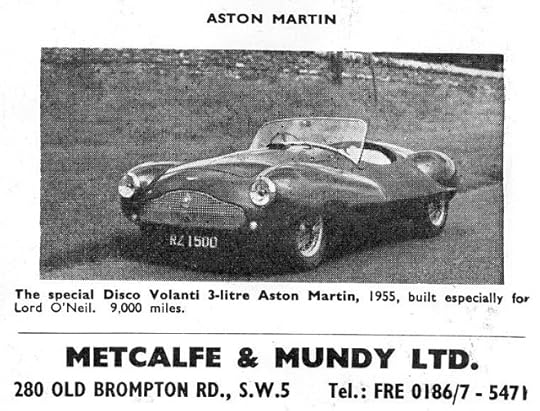

And it so happens that I’ve briefly ended up in a flat in Harcourt Terrace SW10, between Fulham Road and Old Brompton Road, an area which might possiblybe thought of as Chelsea, though the nearest Tube station is Earls Court. Either way it’s a fairly swanky area, but here’s the thing for a man who sometimes styles himself as a Hollywood Walker: if you walk south down Harcourt Terrace, it suddenly becomes – now wait for it - Hollywood Road.

There’s a Hollywood Lodge:

These people are staring into Hollywood Mews, which has a very nice font:


There’s a salon offering Hollywood Hair and Nails:

There is even the Hollywood Arms, a pub that’s been there since 1865:


None of this, naturally, has much in common with the Californian Hollywood: there’s money there, but there’s also muck. Finding signs of patina and decay is a quite a job in this bit of London – but as I pounded the streets I did feel quite cheered when I saw this ghost sign:

It’s a former showroom for Metcalfe and Mundy who, I discover, were the sole Borgward concessionaires for the whole country.

Borgward were good looking cars but they went out of business in 1961 (though the brand has recently been revived) so this is one very old surviving sign. Fortunately Metcalfe and Mundy didn’t have to rely only on the Borgward. They did a pretty nice line in Aston Martins too.


Published on October 23, 2018 10:13
THE HANGING TREE

I’ve been walking in Oxleas Wood, on the top of Shooter’s Hill in Greenwich. I was with my pal Hugh and his dog Fergus. This is Fergus:

Oxleas Wood is 77 hectares of ancient deciduous forest. Its initial survival is thought to have been because the land was too hilly to clear for human settlements. And it was part of the royal estate from the 14thto the 20thcentury which obviously guranteed that no riff raff would mess with it.
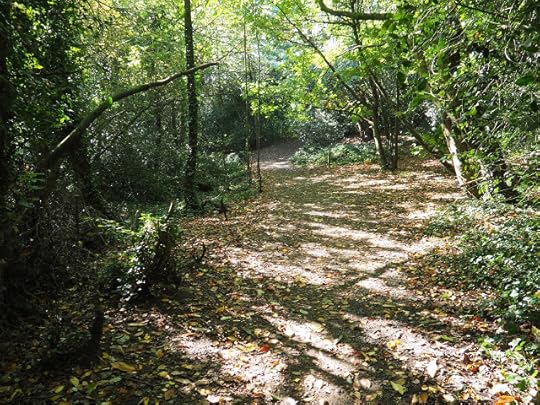
Tucked into Oxleas Wood is Severndroog Castle a great bit of folly architecture built as a memorial to Sir William James by his widow, Lady Jane, after his death in 1783.

Among other things, Sir William James was commander of the East India Company navy, and in 1755 he attacked and destroyed the island fortress of Suvarnadurg, off the coast of what is now India, what was then part of the Maratha Empire. Suvarnadurg currently looks like this:

Severndoorg is the Englished version of Suvarnadurg, though it seems that historically other spellings have been used:
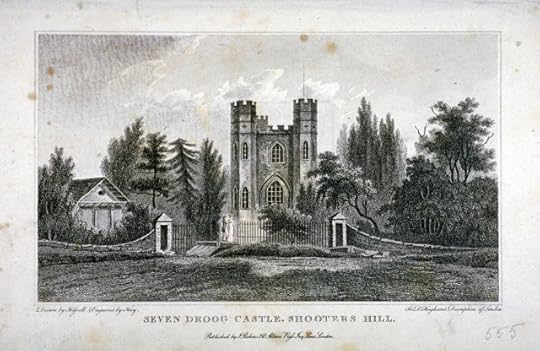
As memorials and follies go it’s genuinely impressive, some fine brickwork and possibly a Thomasson:
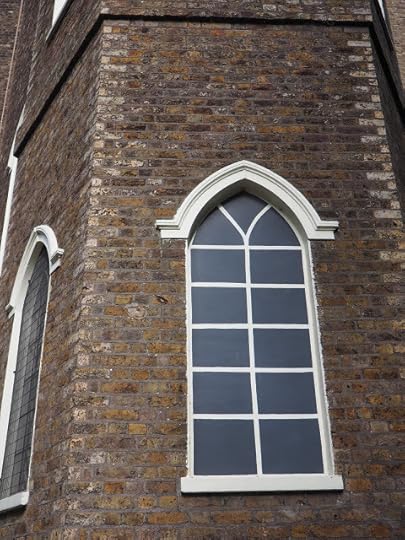
But on the day we walked there, another memorial was visible.
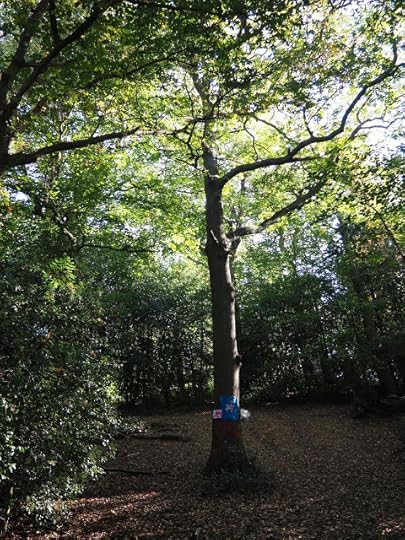
It is a certain tree, unremarkable in itself, that Hugh tells me for a long time had a blue rope attached to one of the high branches, and local kids used to swing on the rope.
The rope has now gone and it’s not a place where children play because a young man, a single dad with a history of what we now call “mental health issues” hanged himself from that very rope. His name was Garry Guest. He was, inevitably, found by a dog walker.

The lower part of the tree has now been turned into a rough, makeshift memorial that is gradually being worn away by the elements. It’s strangely moving in its roughness and decay, not least the photograph and the empty Strongbow can.

No doubt it will not last as long as Severndroog Castle but in its way it's far more moving.

Published on October 23, 2018 05:01
Geoff Nicholson's Blog
- Geoff Nicholson's profile
- 55 followers
Geoff Nicholson isn't a Goodreads Author
(yet),
but they
do have a blog,
so here are some recent posts imported from
their feed.


